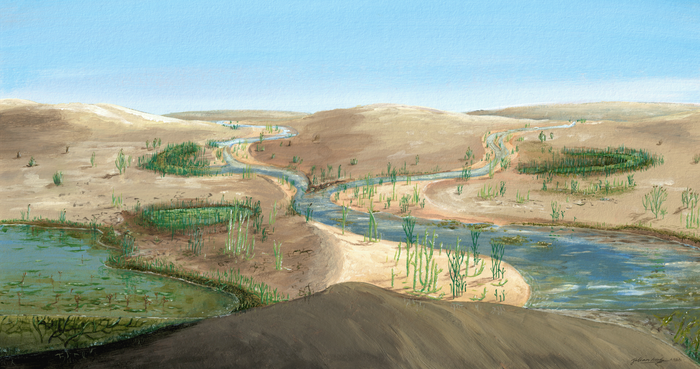How did plants migrate from living in water to land 400 million years ago? Mystery solved!
The green world that we live in would not have been possible without hidden changes to the plant body over the last 400 million years.

[Nov 14, 2022: Miroslava Dvorakova, Institute of Botany, Czech Academy of Sciences]
Artist’s impression of the landscape over 400 million years ago, when plants began diversifying the arrangement of their vascular tissues, increasing their overall stature, and exploring increasingly dry environments. (CREDIT: Julian Kiely)
The green world that we live in would not have been possible without hidden changes to the plant body over the last 400 million years. To grow beyond just centimetres tall outside of the wettest places on land, plants had to re-arrange their water-conducting tissues to keep them safe from drought.
A new study by Martin Bouda of the Institute of Botany of the Czech Academy of Science and co-authors, published in the journal Science, shows how the solution to a hundred-year-old debate in botany reveals a key adaptation that allowed plants to colonise dry land.
Background: All but the tiniest plants need vascular tissues to supply water throughout their body and avoid drying out as they capture carbon from the surrounding air.
If a plant is subjected to drought, the chain of water molecules being pulled up the stem can break, forming an embolism: a bubble of gas that blocks water transport in one entire vascular conduit. If embolism spreads from this conduit throughout the tissue, the plant’s water-supplying vasculature becomes effectively blocked, the plant dries out and dies.
Related Stories
The new discovery shows that the original arrangement of vascular tissues—a cylinder at the centre of the stem—becomes increasingly vulnerable to embolism spread with size.
"If conduits are all bundled up together the plant may face exponential spread of embolism on the resulting vascular network. If they are strung out in a long narrow shape, embolism has to overcome many successive cell walls to go very far, which can save the plant’s life in a drought,” says Dr. Bouda, the lead author of the study
The first vascular plants were just centimetres tall and constrained to live where water was readily available. To grow taller and begin exploring the landscape, they first had to find alternatives to their ancestral vascular arrangement.
Schematic animation of embolism spreading between conduits in two stem cross-sections. In both, embolism crosses half of the conduit walls it encounters. The plant on the left dies, the one on the right lives. (CREDIT: Animation: Martin Bouda, Institute of Botany, Czech Academy of Sciences)
“We were struck by the fact that only very few living plants have kept the original layout of the stem, which puts the vascular tissue in a cylinder right at the centre. That seeming detail actually held the key to deciphering this whole evolutionary episode,” adds Bouda.
The fossil record shows an increasing diversity in how the stem isassembled just as plant radiate out from water sources. Vascular tissue arrangements diversify to take on a vast array of shapes in the stem from ellipses and straps through stars to rings--divergent in form likely convergent in function. Plant lineages that succeeded on land had to each find their own solution to the problem of embolism. The strength of this evolutionary pressure increases with plant size.
A fossilized stem of Dernbachia brasiliensis, a tree fern of the Permian (250-300 million years ago). Water-conducting xylem tissue is highlighted in blue. (CREDIT: Ludwig Luthardt, Museum für Naturkunde, Berlin)
The research resolves a hundred-year-old riddle in botany. The observation that vascular tissues assume increasingly complex shapes in larger plants was first made by F. O. Bower (president of the Royal Society of Edinburgh) and his student C. W. Wardlaw. Bower presented their results in his opening address at the Society’s meeting in 1920 but could not explain the finding.
A century of debate eventually settled on the uncomfortable consensus that the complexity of xylem arrangements simply increased coincidentally as plant bodies grew and branched.
The new study shows that plants maintain drought-resistant vascular arrangements by restricting the tissue’s width. With increased size, the tissue must assume elongated, narrow, and increasingly complex shapes, which provides an answer to Bower and Wardlaw’s riddle.
Numerical simulations of how drought-induced embolism spreads through the vascular networks of real and idealised plants to become lethal confirmed that hydraulic failure should select for narrower, increasingly complex shapes. “By developing new ways of quantifying how the topology of the conduit network affects embolism spread, and by applying those methods to both the early fossil record and living plants, we were finally able to ask the question in the right way,” closes Dr. Bouda.
Applications of this fundamental advance include the potential to secure drought-resistance in crop breeding programs for a changing climate. “Now that we have a better understanding of how the vascular systems are put together and how that influences a plant's ability to tolerate drought, that's the kind of thing that could be used as a target for breeding programs,” says prof. Brodersen.
Follow-up research will ask how plants evaded the newly discovered constraints to achieve woody growth forms.
For more science stories check out our New Discoveries section at The Brighter Side of News.
Note: Materials provided above by the Institute of Botany, Czech Academy of Sciences. Content may be edited for style and length.
Like these kind of feel good stories? Get the Brighter Side of News' newsletter.



